
Original Link: https://www.anandtech.com/show/2534
Before we start, I would like to state that this "article" started out as a short blog a couple of days ago about component choices I selected based on price/performance, and it ended up becoming this multi-page story written in blog form. My apologies upfront for anyone offended by the first person writing style, but providing additional content to the original subject matter sounded like a good idea. So let's see what I purchased before we move on to how well the selected components work in our next article, one that will be more formal.
I recently decided to upgrade a couple of computers in the household. Both upgrades come out of necessity as each machine was nearing the end of its lifecycle and each one started to develop ghost in the machine behavioral patterns. One is my general workstation that more or less serves as a jack-of-all-trades system and the other is my youngest daughter's personal computer that serves as the hub of her communication universe.
Her vast communication universe consists of all the popular instant messaging programs that keep her in constant contact and communication with dozens of friends who always seem to be online even when they are traveling or playing outside. Of course, constant visits to MySpace and other online communities are of upmost priority as is the ability to update her school's website since she is part of the Web Team responsible for it. Just the normal daily life for a ten year old who apparently needs at least a 24" monitor just to keep track of the thirty or so open windows at any given time.
It is certainly different times now compared to when I was growing up. I used to think attaching kite string between two paper cups qualified as a major means of communication with my friends next door when growing up. Yes, the invention of the walkie-talkie had already occurred - and probably fire now that I think about it. However, trying to get the string/cup combination to work as well as that old issue of Popular Science said it would was a real challenge, as was not trying to blow up the garage again.
Getting back to the original task, I had an $850 budget allocated for each system, with a little leeway since I was expecting a three-year cycle for each platform. Of course, I already had in mind that both platforms would be easily upgradable to extend their lifespan a little longer if required. We generally adhere to a very strict budget in our household and this was going to be one of those major expenses for the year so the leeway was not that much.
Fortunately, I had bought new monitors for each of us last year so that major expense was out of the way. We both upgraded from first generation Acer 22" LCD panels (Ed: wonder what the parents will get for Christmas this year…) to the Gateway 24" FHD2400 we recently reviewed. I ended up purchasing a couple of under 30 day open box returns for $279 each, a major expense yes, but about $200 less than street price along with a new warranty.
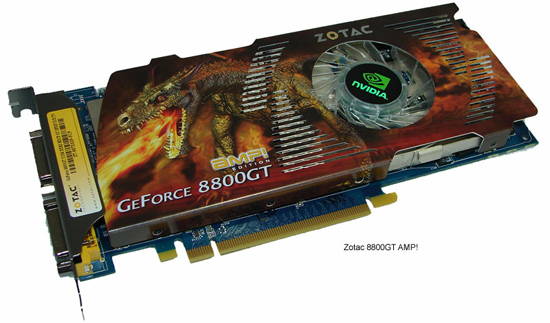
At this point, I like to quip with the wife that you have to spend money to save money. However, I have to admit that finding a bargain is of upmost importance when spending my own money on computer equipment. You might find that statement perplexing considering the website I work for, but there is rarely an opportunity to utilize products we review. When that opportunity does strike, I like to use my lab pass to score components for my son's gaming habits.
As such, hunting for bargains online and at local stores like Frys' - along with trading components with friends just as obsessive about computers - is the standard operating procedure. Still, I have to admit that just ordering components from an e-tailor like Newegg, NCIXUS, or several other sites is sometimes the quickest method I utilize when time is not on my side.
I had also secured a couple of SilverStone SG03 cases from a distributor that was going out of business for a price I am embarrassed to print. Like most users, space is an issue so going smaller on the case was going to help reduce clutter in both rooms by replacing a couple of custom Lian Li cases I had built during the case mod craze a few years ago. They looked spectacular at the time, but now they seem to be completely out of place. (My daughter covers hers up with a small blanket when friends are over.) In fact, even visitors to the house seem quietly offended by them. It's kind of like when old "Uncle Burt" comes over and tries the "pull my finger" trick on our kids who no longer find it amusing.
Operating System
Both systems will be moving from XP to Vista. Some might consider that a downgrade of epic proportions, but I have grown fond of Vista 64-bit and even more fond of 4GB of memory utilized properly by the operation system. Setting up Windows 2008 Server in a workstation configuration crossed my mind as a way to utilize my MSDN subscription extras, but I decided in the end to just pop the Vista 64 install DVD in and go for it. For those who prefer Linux, I am not quite ready to use it 24/7 but one of these old platforms is now a dedicated Linux machine for my continuing educational needs.
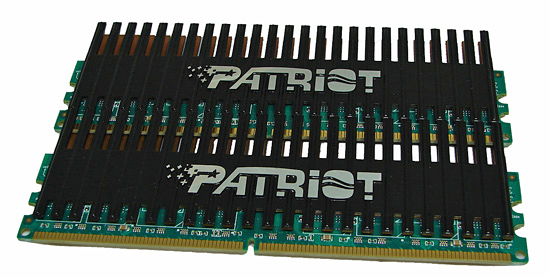
Memory
The first item I went shopping for was memory. After spending the past few weeks testing multitudes of 2GB DDR2 modules, I concluded that I wanted a 2x2GB DDR2-800 CAS4 kit based on the best blend of price to performance in that category. Sure, CAS5 would more than suffice for our needs and most of the CAS5 modules could be coaxed into CAS4 operation with a bump in voltage or relaxing a couple of timings. However, having the security of plug in and forget about it was worth the extra couple of dollars for CAS4.
The next decision was which supplier to utilize. The easy choice would have been the companies we typically choose for our test bed components or those that have received great reviews from us or other reputable websites. To be honest, this was a difficult purchasing decision, made especially difficult after the testing we just completed. The choices and results clouded an already muddied mind, as there was not a bad kit in the bunch - certainly not one I would ever hesitate to purchase.
I let my budget constraints sway my search process but still ended up with a top-flight choice in the Patriot PVS24G6400LLK DDR2-800 CAS4 4GB kit. When I purchased the memory it was $74.99 for a 4GB kit with rebate, but I had to pay shipping costs so the current $79.99 price with free shipping is actually a better deal at Newegg. Considering both machines will have multiple browser windows, IM programs, and general office applications open at once along with a heavy dose of Photoshop, Dreamweaver, and Premiere Pro activities, I broke the bank and bought 8GB for each machine. Stretching the budget will become a common theme throughout my component selections. (It is also a reason why I will need to eBay my John Travolta signature 70's Disco clothing lineup now.)
I figure 8GB should be good for the next three years and solidifies my thought process that you can never have enough memory with a 64-bit operating system. Patriot recommends 2.2V for CAS4 operation at DDR2-800 with 4GB. I tested this memory on several boards and got away with 1.85V~1.90V with 4GB at 4-4-3-10 timings, well under the 4-4-4-12 2.2V recommendation. I had to increase VDimm to 2.0V and timings to 4-4-4-12 at DDR2-800 with an 8GB configuration on the boards I purchased. To say that I have been pleasantly surprised with this choice would be an understatement. As usual, your mileage will vary depending upon other components and usage patterns.
Power Supply
Next up is the power supply. This is a component that I look at as an investment since a quality power supply will last for several years and is extremely important in ensuring stable operation of your system. I take this purchasing decision seriously and balance system needs, acoustical considerations, and unit quality when determining what item to select. The power supplies I have in the current systems have served me well for the last five years, but they are no longer up to spec for the components going into the new systems.
That said, I do have a budget to adhere to so I was extremely surprised to see the PC Power & Cooling S610EPS Silencer marked down from $199 to $89.99 with rebate. The power requirements for our systems do not call for this type of wattage and a high quality 380W~430W unit would do just fine. However, for the extra few dollars (Ed: here we go again…) the lure of the S610 Silencer was just too much to resist, especially if a mid-life GPU upgrade requires additional power or these power supplies migrate to other systems. One caveat: this power supply is a little longer than normal and required a shoehorn to get it into our SG03 case.
Another power supply that deserves special mention and one I purchased this week for another article is the Silverstone ST50EF-SC 500W unit that Silverstone designed with this case and other SFF units in mind. The unit features shorter than normal cables so your SFF case is not as cluttered. The unit is very quiet, has an excellent efficiency rating, uses high quality components, and comes with dual six-pin PCI Express connectors for the same price as the S610EPS Silencer.
Processor
The processor choice determines our motherboard and GPU selection. Personally, I like both Intel and AMD for processors so I have an open mind on this subject. I use a mix of Intel and AMD processors at home and work. Both companies make excellent products so choosing either one is a win/win situation. If I were building a gaming rig or dedicated audio/video workstation, I would lean strongly towards an Intel Q9450 or E8500 as my processor choice, although a Phenom X4 9850 is a solid option for those in the AMD camp. Those recommendations are based on having a different budget so when looking at the lower end of the price spectrum, it becomes obvious that AMD has a stronger selection of products.
Our systems will see a variety of usage that includes web creation, audio/video encoding, gaming, HD playback, and of course heavy communications work. As such, a dual-core processor is a basic requirement and for the audio/video encoding and multimedia work, quad-core would be nice. Clock speeds are somewhat important so our two Intel choices come down to the Q6600 at around $219 (over budget) or the new E7200 at a relative bargain price of $131 for the latest 45nm technology. I seriously considered the E7200 matched with an Intel branded G35 board and would not hesitate to recommend that combination for others. Nevertheless, something else caught my eye - or more like I already knew what I wanted but was afraid to admit it.
On the AMD side of the fence, we have the new 45W processors that include the 4850E, which is a match for the E7200 in most of our applications while offering very good power dissipation numbers. However, looking at our usage patterns, one processor stood out to me. Maybe I like being quirky or notice the ugly ducklings with potential, but the new Phenom X3 series seemed like a perfect match for future needs even though the budget would suffer. Also, they have proven to be relatively overclockable, which will come in handy if additional CPU power is required.
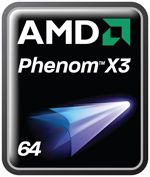
The Phenom 8750 is overpriced in my opinion at $195 and the 8450/8650 at $145/$165 dollars is right on the verge of being annoying to accept looking at the price/performance ratios. However, I found an autographed Bee Gees album in the closet of lost dreams. That should get me the extra $20 I am going to spend on the Phenom 8650 with its 2.3GHz clock speed. Honestly, that is the absolute minimum speed you want to have with Phenom.
This CPU choice gets us the latest AMD technology (Intel fans can insert a variety of sarcastic remarks here) but more importantly an extra core. That extra core actually comes in handy during heavy multitasking, especially if you stick with an IGP solution like the AMD 780G or NVIDIA GeForce 8200 as you can watch an HD movie with full post processing and still perform tasks in the background - something that brought our E7200/G35 system to a standstill. However, this will not be as important to us since we are using discreet graphics cards with HD playback capabilities. As a side note, after working with both configurations, the X3 definitely is better at multitasking under heavy loads, the type of loads these systems generally see on a daily basis.
Motherboards
Our case dictates a uATX form factor motherboard. Fortunately for us, the choices are numerous for the socket AM2+ format we require. Since AMD has concentrated on (or been forced to) the low end sector the past couple of years, the chipset and motherboard suppliers have responded with some very good chipsets following the AMD 690G chipset launch last year. The two primary chipsets I focused on are the AMD 780G and NVIDIA GeForce 8200/8300. The supply situation is better with the AMD 780G at this point but the GF8200/8300 is a very completive offering.
Either chipset would work for our requirements. In fact, if these systems were not using discrete video cards, I would have chosen the 780G based upon the performance of its IGP. The GF8200 holds an advantage by offering 8-channel LPCM audio over HDMI compared to two-channel for the 780G, but with recent driver changes turning off 6-channel LPCM output, NV is effectively neutering their chipset for reasons we cannot explain. In the end, based on using a discreet graphics card, either chipset was fine for our configuration.
Now that I had settled the chipset question (sort of), it was time to find the right board for the right price. The de facto standard in this market sector right now is the Gigabyte GA-MA78GM-S2H, and rightfully so. It would have been very easy to just select that motherboard and end my search quickly. However, in this market sector there are alternate choices and I like to spread my money around to other suppliers at times. I had a request from a couple of family members to build them basic "SOHO" machines so I had a little leeway in ordering several uATX boards and then choosing which one I would use.
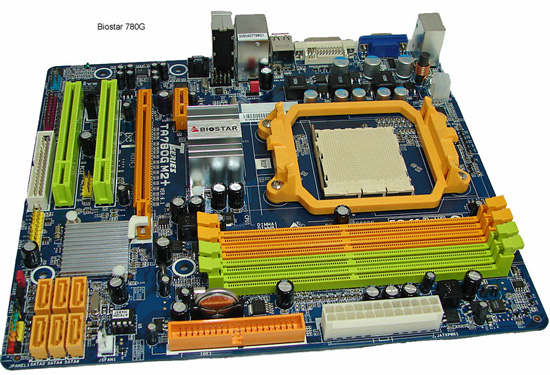
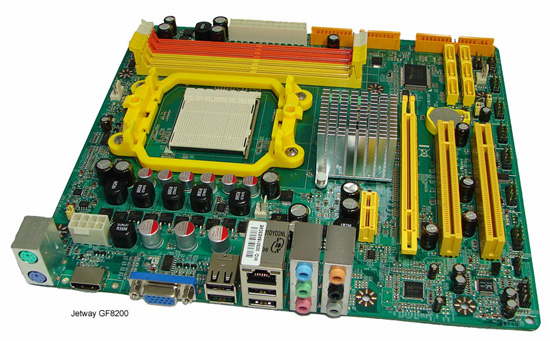
The Gigabyte board was first on the list, but it ended up with Anand for his Home Theater construction masterpiece. Even so, some very competent choices stayed at home. The Jetway 780G PA78GT3-DG and GF8200 PN78SM3-HL, Biostar TA780G M2+, Sapphire PI-AMDRS780G, and ASRock 780G A780FullDisplayPort all were used in personal system buildups. I would like to mention that the J&W JW-RS780UVD-AM2+ and Zotac GF8300 were highly sought after based upon test results but those products were not available in the US at time of purchase. Currently, the Jetway and Biostar products are in and out of stock at various e-tailors, but the others listed were in stock at several locations today.
I planned on a smooth "exit stage left" routine without saying which motherboards are staying in my personal systems, but I am sure somebody would have noticed the lack of commitment on the subject. In the end, the Biostar 780G is in my system and the Jetway GF8200 board is in my daughter's system. How did I come to that decision? It came down to the location of the PCI Express x1 slot on each board. This small design difference changed the original plan of installing the GF8200 board in my system and I will go over that decision shortly.
The Jetway 780G and Sapphire 780G are in systems for my parents, who are both active computer nuts well into their seventies now. The ASRock 780G product ended up in another system for testing. I will explain that in another blog shortly. I will sum up the motherboard choices by simply stating that there are other choices in the market worth considering before making a purchasing decision. These brands listed today may not be from Tier-1 suppliers, nor offer the greatest amount of features or overclocking capabilities, but so far they have performed extremely well as the heart and soul in these jack-of-all trades systems.
Video Card
To some degree, the onboard graphics capabilities of the GF8200 and 780G would have sufficed for the majority of our needs. However, I like to play RTS or Racing/Flight Simulation games when time is available (wishful thinking actually) and my daughter is a big Sims 2, Rollercoaster Tycoon 3, and World of WarCraft fan. The capabilities of the 780G and GF8200 allow these games to perform reasonably well in resolutions up to 1280x1024 depending on quality settings, but we wanted to stick with the native 1920x1200 LCD resolution where possible so a discrete card is mandatory.
Since the games we play are not as graphically demanding as current FPS titles, we have some latitude in our selections. The first GPU that popped into my mind is NVIDIA's 9600GT. This chipset offers excellent performance for the price and has the HD display output capabilities we both need. The AMD HD 3850 was also a logical choice, especially with the budgetary requirements. However, not being logical at times can pay off. Considering the fact that I would like to get a good two years out of our GPU selection, it was time to move up market for something a little more powerful but a choice that would not break the bank.
I might have OCD, but in my experiences, keeping the same chipset manufacturer for both the motherboard and GPU seems to reduce the number of variables to diagnose when something goes wrong. In addition, at least subjectively, performance always seems a little better if it is an NVIDIA GPU on a NVIDIA board and the same with AMD.
With that thinking in mind, I decided to go for an HD 3870 card for my 780G machine. We have used the MSI, ASUS, and Gigabyte cards extensively in the labs and any one of them is an excellent choice. At any time, you can find several HD 3870 cards on sale for $149~$159 from various manufacturers. Knowing how cramped our case is and subject to increased thermals with our component loads, I decided on the Sapphire Toxic Radeon HD 3870 card as it runs about 5C cooler than other cards and it features a single-slot cooling design that is a requirement. The price of $159.99 after rebate was a little higher than the budget allowed, but by this time you have figured out the budget is flexible - at least until the Visa bill arrives.
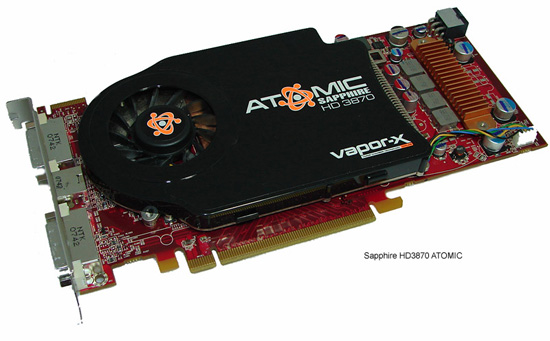
For the GF8200 board in my daughter's system, I really debated whether to go the 9600 GT or 8800GS route, but knowing Spore and Sims 3 is on the horizon it appeared a little more power would provide some safety. So I decided on the 8800GT 512MB and like the AMD cards, there are numerous cards on sale at various times ranging from $150~$170 range. In the end, it came down to the MSI NX8800GT 512M OC at $159.99 or the Zotac 8800GT AMP! at $154.99 after rebates. The MSI card runs the core GPU clock at 660MHz and the Zotac at 700MHz, both guaranteed clocks above the 600MHz standard, which is nice to know that the supplier is promising an overclock without repercussions. Besides the slightly better price, the Zotac card had one large advantage: a single-slot cooler design, which is perfect for our uATX case.
I have to say I am very impressed with both video cards, from not only a design viewpoint but also looking at performance in our primary applications. However, the games I play benefit greatly from anti-aliasing and the HD 3870 suffers in this area when compared to the 8800GT. I knew that going in and it was the primary reason I wanted the GF8200/8800GT combination. I simply could have bought another 8800GT from Zotac and used it on the AMD board without problems, but between the OCD and balancing funds to each competitor, I decided to let my fondness for music make the decision. I will explain why in the audio section.
When it comes right down to it, the HD 3870 even with AA/AF enabled still provides very good performance for my needs. In addition, I still think AMD has a slight edge in Vista driver compatibility and desktop screen quality after comparing the two systems. Zotac includes an extensive accessory package along with a solid design that just gives you a secure feeling about the product and that the company backing it knows what the customer wants. The Sapphire package and product design also gives you that same sense of security and the card just looks right in the system, what little of it you can see.
With the major component decisions out of the way, it was time to make a decision on what peripherals I wanted and then those that I could actually afford. It turns out in my original budgeting process that I made some assumptions on cooling and audio that were wrong - at least wrong in the fact that I thought the retail kit extras or "hand me down" components would suffice. Of course, the thought of having a shiny new trinket was too much to resist also. Therefore, besides the John Travolta autographed Saturday Night Fever wardrobe and Bee Gees album, it appears my Brad Delp autographed Boston paraphernalia will see action on eBay now.
Cooling
The SG03 case comes with a very good 120mm fan and has an option for a second 120mm fan in the case. Considering the setup being installed, I decided another fan would be wise. I have always liked the Noctua NF-S12-800, but since the inclusion of additional case fans was outside the original budget I could not afford two of them. Silverstone offers a nice series of fans including the FN121 already installed in the case. At $9.99, it was a relative bargain but another fan that Wesley has recommended to me a hundred times showed up in the same price range. I have used Scythe fans in the past and always liked them. I decided to remove the Silverstone fan in my case, install it in my daughter's, and purchase a couple of fans for my system that provide very good airflow with excellent acoustics. The price of $12.99, down from $29.99, sealed the deal for me and I ordered two of them.
I had planned to use the retail Phenom X3 heatsink, but even though it fit fine, the clearances in this case were just a little too close for comfort as I wanted some additional maneuvering room. I had an extra Arctic Cooling Freezer 64 LP cooler that would have worked, but my OCD kicked in again so I went on the prowl for something different. Silverstone offers the passive NT06-Lite cooler designed with the SG series of cases in mind - provided you have the right power supply. Besides having a power supply with a different layout, the unit was just too large for my tastes.
I figured my best opportunity would be a 1U or 2U type cooler. Thermaltake offered a unit that looked perfect but it was socket F/1207 only. After several product searches, I ended up back at Silverstone with the NT07-AM2 low-profile cooler. However, this unit is for 65W or lower TDP processors and our Phenom 8650 X3 is a 95W TDP design. I decided to take a chance after finding one on clearance for $12.99 and $3 shipping. It worked fine at idle and under light loads, but for gaming or heavy encoding activities it just could not keep the X3 in the 50C~54C range that I needed.

I was back to square one; a couple of low-profile coolers from Cooljag/Dynatron would have worked except the noise levels were going to be significantly higher than the retail cooler at load. I had a friend suggest the Scythe Shuriken cooler and Cooler Master Vortex 752 that were working well in his HTPC configurations. I decided not to take the risk of spending more money or having my friend tear down his system. Anyway, cost reared its ugly head again with these options.
At this point, I pulled a Zalman CNPS-8700 out of my HT system just to see how well it would fit as I started to rethink my obsession with creating as much free area as possible around the CPU socket. The Zalman would work; the problem was a $54 price tag that I could not afford. It appeared I was going to have to settle for the retail cooler after all... until I went closet diving.
I remembered I had bought a couple of coolers from Rosewill when the Phenoms first arrived, but I never had a chance to use them after I realized the Phenoms were not going into normal system builds anytime soon. After digging through what I can only describe as a historical treasure trove of computer related items (Ed: stuff he is too lazy to dump), I found the box containing two Rosewill RCX-Z1 units. At first glance, they really did not seem to be an improvement over the retail unit and I started wondering why I purchased them.
It then occurred to me that this particular model comes with a fan controller that allows the user to tailor their fan speeds and is the reason I purchased them. I will say in testing that these units operate quieter than the retail units do, especially when you run the fan on low speed. Temperatures are about 3C~4C lower than the retail unit when the fan speed is above 85%. Whether it is worth $20 over the retail unit is debatable for a stock system. However, since they were technically "free" at this point, I was going to use them and deal with my phobia about the space requirements.
Storage
I network our household computers through a home-built server unit that features 4TB of storage capacity so I have not been that concerned about disk space on the local machines. However, after a total meltdown with Windows Home Server earlier this year, I have become a bit more interested in keeping backups of critical files on the local machines, plus game and application installations are multi-gigabyte affairs now. Windows Server 2008 has replaced WHS and an upgrade to 8TB is coming online after Computex, so the network storage requirements are set for the near future.
I have always favored a fast hard disk on the local machine and the 150GB WD Raptor has been my favorite drive the past couple of years. However, after looking for the best balance of price, performance, and storage, one drive stood out from all others - so much so that the majority of my home machines are now sporting the Western Digital Caviar SE16 640GB hard drive. At $99 it is pretty much a no brainer purchase if you are looking for a new hard drive on the desktop. The WD SE16 640GB is one of those drives that offers a near perfect blend of capacity, performance, acoustics, and thermals at an incredible price point. The one exception I have is in my HT machine that utilizes a couple of the Seagate DB35.3 750GB drives dedicated to video recording activities.
Considering my daughter's machine will need to perform BD (Blu-ray Disc) playback at various times plus the need for the standard DVD burning activities, I decided to get a BD combo drive for her. Another pressing need for a combo drive stems from the SG03 case only having a single 5.25" external slot. I already have the LG GGW-H20L drive in my HT machine and just recently traded a couple of ATI 2900XTX cards for the LG GGC-H20L drive that is seeing duty in the server now.
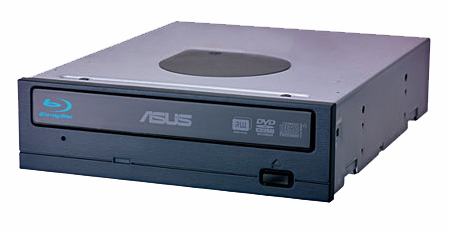
Yes, I can stream HD video through the network so I do not truly need a combo drive, but my daughter's friends like to bring over BD discs and it is just easier for me to let them play the titles locally. The LG GGC-H20L would be the logical choice as we still have several HD-DVD titles (about 45 or so - thanks Toshiba) but even the very reasonable street price of around $170 is out of reach thanks to my earlier budget busting activities. We utilize the Sony BDU-X10S drives in our test beds and it is a terrific drive. Once again, the average street price is around $170, putting it just out of reach for us, as I needed to purchase a standard DVD drive for my machine. One would think I would have something in the closet of lost dreams, but for whatever reason I tend to be hard on optical drives and actually have several that need to be disposed of shortly.
I ended up getting the ASUS BC-1205PT drive for $150. After a firmware update, this drive has actually impressed me and BD playback is flawless even with the BD-R DL playback locked at 2x. Seek times seem to be a little high to me compared to the LG and Sony drives while overburns are limited along with the inability to set book type on DVD+R or DVD+RW media. Overall, write quality is very good and that was my major concern. Of course, it is a SATA drive so cable management is a big plus in our cramped case. The LITE-ON DH-401S-11 drive was available at $130, but the last one I bought did not last very long. Those things happen, but I did not want to go down that path again.
I did not hesitate in purchasing the Pioneer DVR-215D 20x DVD-R/+R drive for my system. Fortunately, I got the black OEM version for $27 on sale; otherwise, my next choice would have been the Samsung SH-S203N or the new Samsung SH-S223F drive. One thing I have learned as of late is the need for a multi-card reader what with everyone in the household having various camera and camcorder formats, so it was about time to purchase a couple of additional units. I was able to snag two Transcend M3 units at a local store for $9.99 each - a heck of a deal on a top-flight unit.
Audio
Remember a few pages back (don't worry, I barely remember myself) when I had to make a decision on which board to put in my system and it came down to the layout of the Biostar and Jetway board? The decision is because I wanted to upgrade from the Realtek onboard sound (HDMI audio out is not being used) to something better - mainly for listening to music, but movies and gaming would also get a boost. The Jetway board does include a PCI Express x1 slot but due to the GF8200 heatsink location, it is only good for half-length cards. That knocked what I consider one of the better "value" audio cards out of contention for me on that board.
The audio card I am enamored with is the ASUS Xonar DX 7.1 at a reasonable $89. This card offers every possible option I need in this particular system while offering exceptional sound quality for music and DVD playback. Gaming performance is very good and with the last driver updates, even the EAX 5.0 emulation is coming up to speed quickly in both quality and compatibility with the latest games.
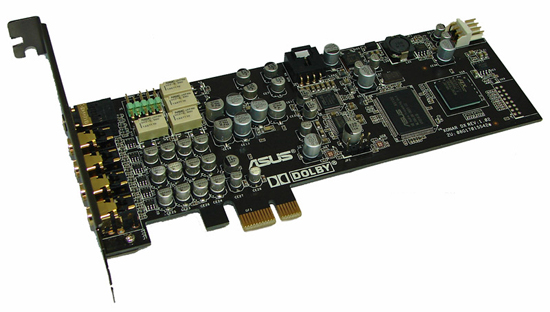
The Xonar DX features ASUS' AV100 audio processor - really just a name change to a large degree from the AV200 used in the D2X card. The DX utilizes a combination of Cirrus Logic CD4398 and CD4362A DACS for analog out duties compared to the Burr Brown PCM1796 DACS in the D2X card. Analog-to-Digital duties on both cards are handled by Cirrus Logic with the DX utilizing the CD5361 and the D2X having the CD5381.
Besides slightly lower signal-to-noise ratings on the DX card, it drops support for DTS interactive encoding, although Dolby Digital Live encoding is still available as is Dolby Headphone and Virtual Speaker. Anyway, the DTS feature is not that important to me as I only have a 2-channel setup on this particular system. About the only problem I have run into is with the microphone settings; at various times I get static or dropout while on Skype that required turning on microphone boost and increasing microphone volume to 85% or more.
For my daughter's system, I chose the Auzentech X-Plosion 7.1 DTS Connect card based on previous experience. In addition, the latest driver release on 5/19 addressed several problems under Vista. Of course, it did not hurt that I picked up an open box return sample with new warranty for $54.99. While my daughter probably could have lived with the onboard audio, her movie, music, and game addiction called for something better. This card offers real-time DTS and Dolby Digital Live encoding via the C-Media CMI8770 chipset along with swappable OPAMPS. Although I prefer the recently canceled X-Meridian card, it was not available at this price point.
Speakers
I decided since we were upgrading the systems that maybe a change was in order for the speakers also. Our desktop space is limited so a 5.1 system is out of the question - although for my daughter, it would make sense considering her movie watching habits. Our Sonigistix Monsoon MM 2000 units are getting a bit long in the tooth, not from an audio experience, but the general wear and tear for the last six years have left our sets slightly damaged. While a steady stream of super glue has kept the speaker stands in working order, cable tears and the occasional drink spill have left the sets needing some serious TLC to work perfectly.
This upgrade is a budget buster and something I did not plan on when the process started. I thought about moving around a few speaker sets between the other computers but space and application needs dictated something different. I have not been a big fan of most personal computer speaker systems although Logitech, Klipsch, and Creative have had their fair share of success in the upper-end market. I own products from each supplier but they are 5.1 configurations.
I can get away with a 2.0 system and my daughter will just need a solid 2.1 configuration. Certainly, I was looking in a price range that would not completely break the bank or send a red flag up for a divorce lawyer. Something like the Logitech Z-2300 for my daughter or the M-Audio StudioPro 3 for me was in order since prices were under $100 each. In fact, even discussing speakers is probably going to be controversial as audio quality can be very subjective at times. What my ear hears from these speakers can be completely different from another person sitting next to me. My suggestions suit the requirements I have and more importantly, how I like to listen to music. There are certainly other choices available in the price ranges I selected and they might be even better than the brand name I like.
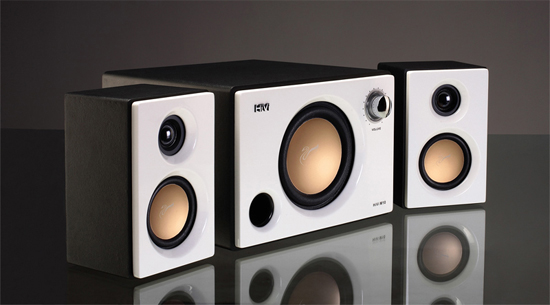
I have always been a big Swan fan and someone will have to pry the M200MkII from my cold dead hands before I give them up. The new M12 units probably would have been perfect, but knowing my daughter would not really notice the difference I saved some money and bought the Swan M10 setup for just a few dollars more than the Logitech Z-2300. While the Logitech speakers win the battle of the bass, the Swan's provide just an incredible clarity with superb mids and highs for the money. The soundstage comes across as being larger than it actually is and instrument separation is excellent. The subwoofer has an excellent and responsive upper bass that matches very well with the midrange, but down low it could use a little more punch (certainly if you like thumping bass) and decay times are poor compared to larger units. The subwoofer is best placed on the desktop if possible. About the only drawbacks are the volume control on the sub, the satellite cables being soldered, and the four-foot cables. Otherwise, this almost perfect desktop setup offers a very intimate and smooth soundstage that even got a big thumbs up from my daughter - not only for the sound but for the looks as well.
The M10 units would have suited me perfectly and I probably should have gone that direction for saving money also. However, being the one to try something different, I decided to look at the Swan D1080MkII series after understanding them to be an inexpensive M200 substitute. First off, let me say they are not an M200 substitute, but I doubt anything in this price range is or could be. That said, these speakers actually sounded better to me than the M10s in most instances, even without the subwoofer.
The high frequency definition and transient response is very good along with smooth and clear highs after the break-in period. The midrange is close to the M200 series and is the greatest strength of this speaker set. I would grade it somewhere between very good to excellent with sharp transients, stable imaging, and a very open but neutral sound stage. The upper bass is very good and provides a seamless transition into the midrange. Obviously, without a sub the lower bass is trails off quickly, but there is a little punch in this design. However, this setup is not for heavy rock/hip-hop listeners or those who like deep pounding bass in their movies.
I listen to an eclectic mix of music and these speakers are great for classical, classic rock, jazz, pop, blues, country, and other music that tends to emphasize vocals or instrumentation. Surprisingly, gaming and movie playback are very good, except in titles where deep or loud explosions are the norm. In the end, I would probably recommend saving for the M200MkII speakers but if I did not have that chance, the D1080Mk11 is more than satisfying as a primary 2.0 desktop set.
Quick Thoughts
The first question to answer is exactly how much I spent on both systems. I might as well cut straight to the chase, so here are the numbers.
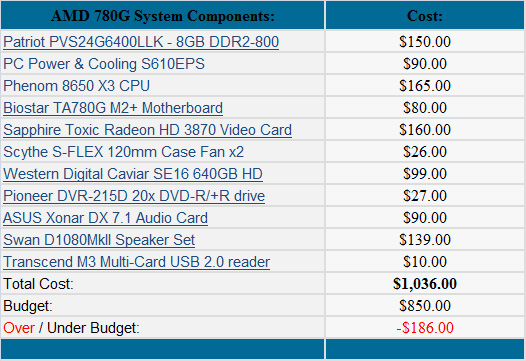
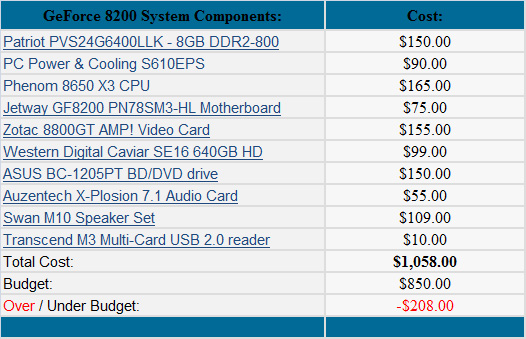
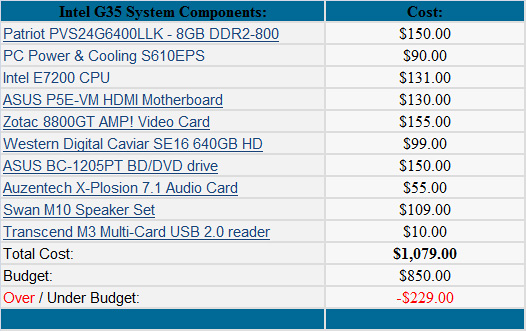
As you can see, the results are not good for my general health right now. Even trading components with friends and searching for bargains still resulted in my system being $186 over budget and my daughter's system coming in $208 above the original target. The total overage was $394 and would have been higher if I had bought the Intel based system. In my defense… wait, there is no defense here. I simply blew the budget by going outside the original scope of my project.
However, if we remove a few items that were not on the original list then the numbers are much closer in total. Going from 8GB to 4GB in each system would save us $150, continuing on with our Monsoon speaker sets would save another $248, and living with onboard sound or pulling a couple of Audigy 2 ZS cards out of the closet saves another $145 while still providing better audio than the Realtek chipsets used on our boards. (Ed: but do you trust the Vista drivers?)
That is a total of $543 that could be saved quickly and would put us $149 under budget. I could collect all the loose change in the car and come up with a dollar or two, enough so I could either go with 8GB in each machine or maybe get the two sound cards instead. There is some room to work with on configuring each system within the budget, and one could easily make the argument to purchase a regular DVD drive for my daughter instead of the BD drive. This configuration change would result in a $123 savings. That would be enough money to move our video card selections up to the 8800GTS 512MB card in each system as one example.
Of course, we could play the "what if" scenario all day and never actually get the systems built. All of this is moot in my case; I already decided what direction to go, purchased the components and have the systems running now. I decided the speaker sets would be a general investment like the previous units. I thought the audio cards were a luxury, but knowing how much the systems are utilized for media playback, the thought of using the onboard Realtek chips meant I was willing to sell just about anything on eBay to keep that from happening.
In fact, after looking at each component purchased and playing devil's advocate with myself, I begin to wonder if building my own system is even worth the trouble now. Heresy for sure, but after doing some serious thinking about the subject there is a little truth in that statement.
The next question is if I got my money's worth. This is especially important since I spent an additional $394 over my budget. There are a lot of things you can do for $394 in this world and computer equipment is at the bottom of the list for most people. I will answer this question in the next article when we see just how well these components perform - not only against the Intel system I thought about building, but against a few components that were on my original wish list.













